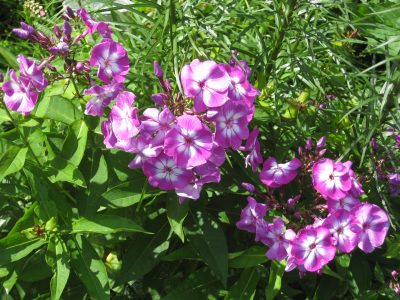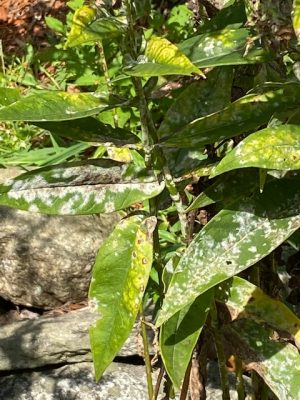By Dawn Pettinelli, UConn Home & Garden Education Center

About now, many of our perennial gardens are looking a bit lackluster. Early summer bloomers have fizzled out and autumn charmers like asters and mums have yet to pop. Garden phlox (P. paniculata) to the rescue!
Annual and perennial phlox comprised about 70 different species, many of which are native to North America. Their habitats range from woodlands to meadow and their growth habits from low and mounded to tall and upright. All have clusters of tubular flowers that are exceptionally attractive to hummingbirds and hummingbird moths along with bees and butterflies.
There are an outstanding number of garden worthy cultivars. My favorite is ‘David’, a white, powdery mildew resistant variety that grows to about 4 feet with loads of slightly fragrant blooms. I have it planted in my white garden and this sturdy, upright plant has come back year after year with virtually no problems.
UConn Plant Science & Landscape Architecture professor, Dr. Jessica Lubell-Brand noted phlox ‘Jeana’, the 2024 Perennial Plant Association’s Perennial Plant of the Year, is treasured for its long blooming period as well as its butterfly luring abilities. Plants can reach up to 5 feet in height and its more loose and wild appearance works well in cottage gardens featuring attractive pink flowers and decent powdery mildew resistance.
Sometimes shorter varieties are a better fit and if that is the case, for your beds look to ‘Coral Crème Drop’, which according to Dr. Lubell are part of the Candy Store series. She raves about their vibrant coral blossoms with their August feel. Another top garden candidate in her book is ‘Glamour Girl’, also with hot coral blooms as well as good resistance to powdery mildew.
A number of garden phlox sport distinctive eyes. ‘Bright Eyes’, as the name implies is a delicate pale pink with a bright crimson eye while ‘Laura’ is a mildew resistant, royal purple variety with a white eye. Both grow to about 3 feet in height.
Many gardeners find these phlox indispensable for August into September color in the perennial garden. They are tough, colorful, vigorous plants that are hardy and relatively long-lived. They make excellent background plants for narrow borders and can bridge the gap between varied sized perennial plantings. Garden phlox come in a wide range of hot and cool colors ranging from white and light pinks, to purples, reds, oranges and magenta.
For healthy, vigorous plants, they should be grown in full sun to part shade. Phlox enjoy a moderately fertile soil with a pH in the 6s. While established plants are fairly drought tolerant, larger and more numerous flower heads are produced when adequate moisture is supplied. They grow at a moderate rate so division every 3 to 4 years is usually sufficient.
Both to encourage sizable blooms as well as to reduce the incidence of phlox’s number one nemesis, powdery mildew, Dr. Lubell recommends reducing the number of stalks early in the growing season to 6 to 8 per plant. This provides better air circulation to plants.

Powdery mildew is a fungus disease that is more widespread during humid, wet summers. It typically does not kill plants, but they look awful with their leaves covered with what looks like white powder. Two options for dealing with this disease according to Dr. Lubell, are to select resistant phlox cultivars or to pre-emptively spray with a least toxic substance like potassium bicarbonate or your fungicide of choice. As stems die or get killed by frost, be sure to remove them from the garden and put in the trash, not the compost pile.
Insects are not usually a problem but during dry, hot summers, spider mites may attack plants. Usually, a strong blast from the hose will knock them off. This may need to be repeated several times if dry weather persists.
A key gardening practice when growing phlox is dead-heading, or removal of spent flower heads. Garden phlox produce a lot of seeds and if left to fall to the ground and germinate, vigorous plants will most likely produce blooms in that undesirable, muted magenta color. Often these seedlings crowd out the more desirable cultivars that were intentionally purchased.
Not only are garden phlox cultivars pretty spectacular on their own but Dr. Lubell says they pair nicely with a variety of other perennials including lilies, yarrow, ballon flower, daylilies, bee balm as well as numerous annuals.
If you have questions on garden phlox or on any other gardening questions, feel free to contact us, toll-free, at the UConn Home & Garden Education Center at (877) 486-6271, visit our website at www.homegarden.cahnr.uconn.edu